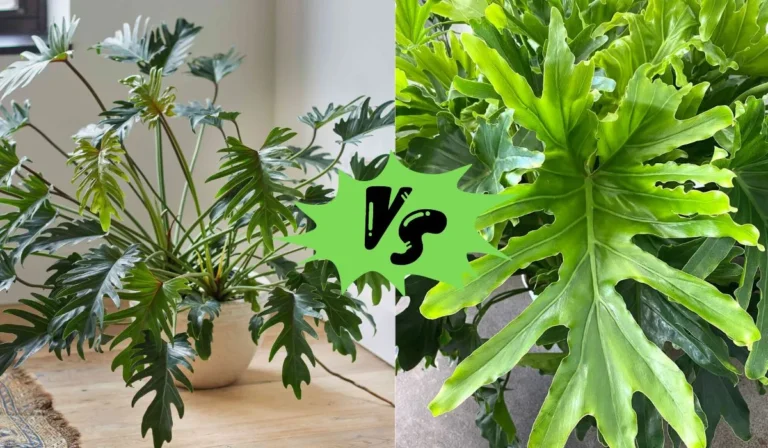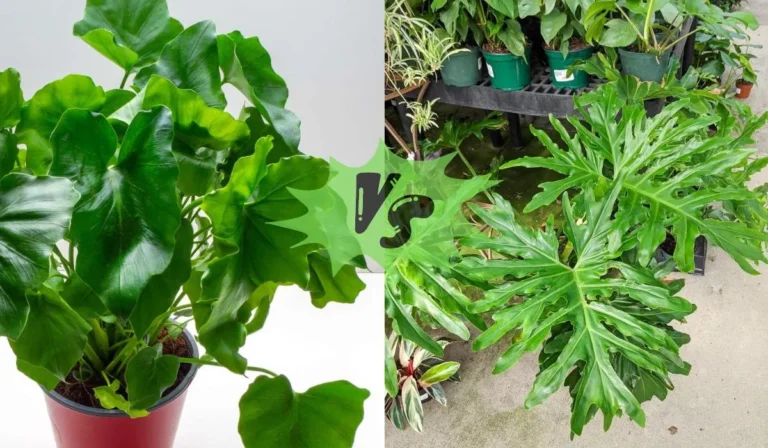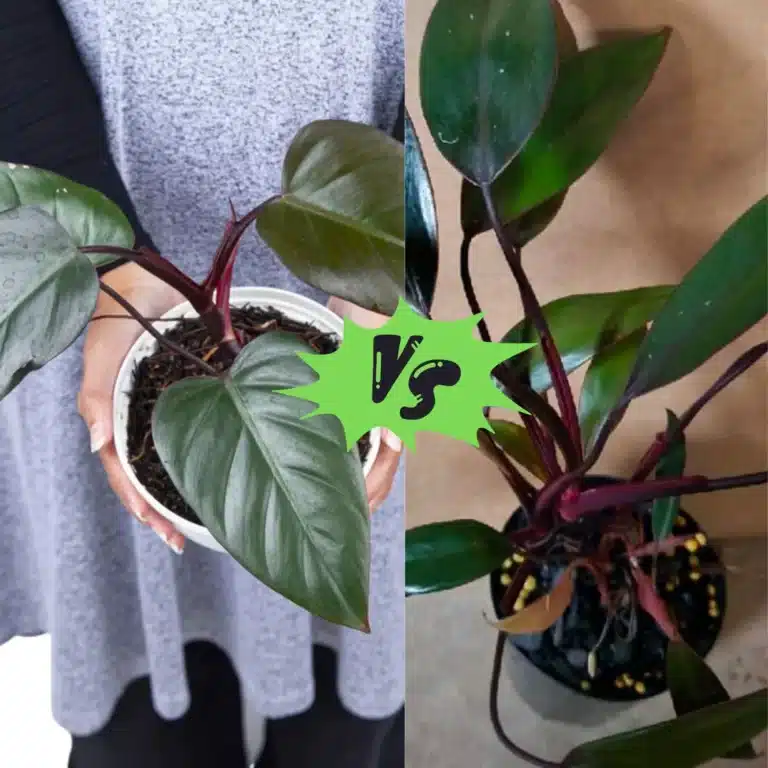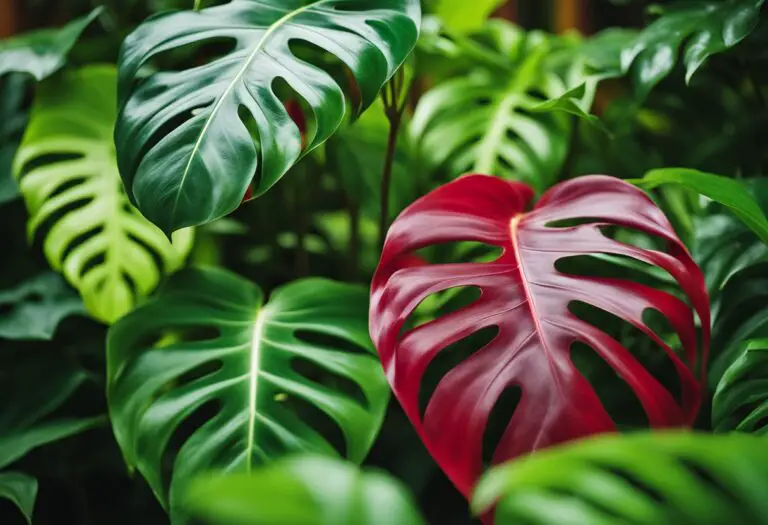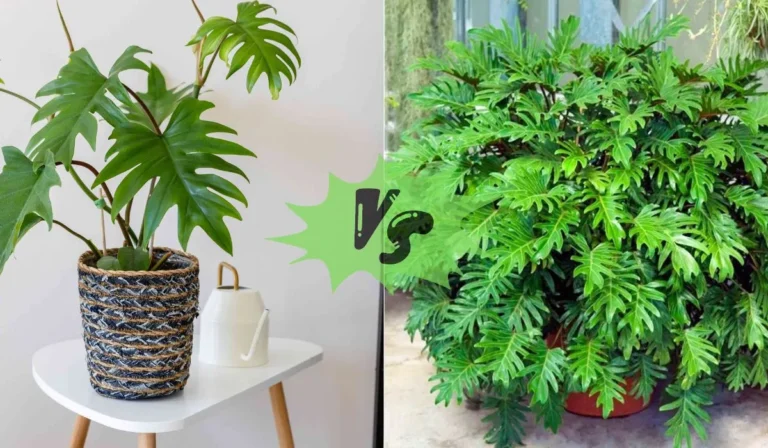Alocasia Dragon Tooth vs Polly: Which Houseplant is Right for You?
Looking to add greenery to your home or office? Alocasias are popular for their striking foliage and easy care. Two varieties: Alocasia Dragon Tooth and Alocasia Polly. This article compares their appearance and care for your choice.
Dragon Tooth has elongated, arrow-shaped glossy leaves with prominent veins. Polly has shorter, wider leaves with a scalloped edge and a matte finish.
Dragon Tooth is larger and more upright, prefers bright, indirect light, and well-draining soil. Polly is more compact, tolerates lower light, and slightly moist soil.

Alocasia Dragon Tooth Vs Polly
If you’re a fan of alocasia plants, you may have heard of Alocasia Dragon Tooth and Alocasia Polly.
Both plants are popular among indoor gardeners and are known for their unique foliage. In this section, we’ll take a closer look at both plants and explore their key differences.
Understanding Alocasia Dragon Tooth
Alocasia Dragon Tooth is a tropical plant that’s native to Southeast Asia. It’s known for its unique foliage, which features leaves with rough edges that resemble the teeth of a dragon.
The plant can grow up to 3 feet tall and requires bright, indirect light to thrive. It prefers well-draining soil and requires regular watering to keep the soil moist.
Understanding Alocasia Polly
Alocasia Polly is a dwarfed version of the larger Alocasia Amazonica species. It’s a popular houseplant that grows up to 18 inches tall and wide, with leaves reaching up to 16 inches long.
The plant requires bright, indirect light and well-draining soil to thrive. It’s also important to keep the soil moist, but not waterlogged.
Key Differences
While Alocasia Dragon Tooth and Alocasia Polly share some similarities, there are several key differences between the two plants. Here are some of the main differences to keep in mind:
- Leaf Shape: The most noticeable difference between the two plants is the shape of their leaves. Alocasia Dragon Tooth features uniquely shaped leaves with rough edges, resembling the teeth of a dragon. On the other hand, Alocasia Polly has more arrow-shaped leaves with wavy edges.
- Size: Another key difference between the two plants is their size. Alocasia Dragon Tooth can grow up to 3 feet tall, while Alocasia Polly grows up to 18 inches tall and wide.
- Coloration: Alocasia Dragon Tooth features leaves that are a darker green with a velvety texture. On the other hand, Alocasia Polly has leaves that are a lighter green with a softer texture.
- Care Requirements: While both plants require bright, indirect light and well-draining soil, Alocasia Dragon Tooth requires more frequent watering to keep the soil moist. Alocasia Polly, on the other hand, can tolerate slightly drier soil.
In-Depth Comparison
If you’re a fan of Alocasia plants, you might be wondering which one to choose between the Dragon Tooth and the Polly varieties. In this section, we’ll take an in-depth look at the differences between the two and help you make an informed decision.
Size and Growth
The Alocasia Dragon Tooth is a relatively new hybrid that was created by crossing the Alocasia Gageana and Alocasia Longiloba varieties.
It is a small plant that grows to a height of about 12 inches and has leaves that are about 6 inches long. The leaves are green with white veins and have a unique shape that resembles a dragon’s tooth, hence the name.
On the other hand, the Alocasia Polly is a cultivar of the hybrid Alocasia Amazonica, which is the source of the name. It is a larger plant that can grow up to 3 feet tall and has leaves that are up to 2 feet long.
The leaves are dark green with white veins and have a shield-like shape that is wider at the base and tapers towards the tip.
Care Requirements
Both the Dragon Tooth and Polly varieties of Alocasia require similar care. They prefer bright, indirect light and should be kept away from direct sunlight. They also require well-draining soil that is kept moist but not waterlogged.
One thing to note is that the Dragon Tooth is a smaller plant and therefore requires less water than the Polly. You should water the Dragon Tooth when the top inch of soil is dry, while the Polly should be watered when the top 2-3 inches of soil are dry.
Another difference is that the Dragon Tooth is more sensitive to cold temperatures and should be kept in a warm, humid environment. The Polly is more tolerant of cooler temperatures but still prefers a warm, humid environment.
Common Problems and Solutions
Both the Dragon Tooth and Polly varieties of Alocasia are susceptible to similar problems.
The most common issue is overwatering, which can lead to root rot and other fungal diseases. To prevent this, make sure to water the plants only when the soil is dry and avoid letting them sit in standing water.
Another problem that can affect both varieties is spider mites. These tiny pests can cause damage to the leaves and stems of the plant. To prevent spider mites, make sure to keep the plant clean and free of dust and debris. You can also use a neem oil spray to help control the infestation.
Choosing the Right Alocasia for You
Are you considering adding an Alocasia plant to your collection but not sure which one to choose? With so many varieties available, it can be overwhelming to decide which one will best suit your space and lifestyle.
In this section, we’ll break down some key factors to consider when choosing between Alocasia Dragon Tooth and Alocasia Polly.
Consider Your Space
Before selecting an Alocasia plant, it’s important to consider the space you have available. Both Dragon Tooth and Polly can thrive in a range of conditions, but they have different growth habits that may impact your decision.
- Size: Alocasia Dragon Tooth typically grows to be 1-2 feet tall, while Alocasia Polly is a dwarfed version of the larger Alocasia Amazonica species, growing up to 1 foot tall. If you have limited space, Polly may be a better choice.
- Light: Both plants prefer bright, indirect light, but Dragon Tooth can tolerate slightly lower light conditions. If you have a room with less natural light, Dragon Tooth may be a better option.
Consider Your Lifestyle
In addition to space, your lifestyle can also impact which Alocasia plant is right for you. Consider the following factors:
- Watering: Alocasias prefer consistently moist soil, but overwatering can lead to root rot. If you tend to forget to water your plants, Dragon Tooth may be a better choice as it is more tolerant of dry soil.
- Humidity: Alocasias prefer high humidity levels, so if you live in a dry climate or don’t have a humidifier, you may need to mist your plant or place a tray of water nearby. Dragon Tooth is slightly more tolerant of lower humidity levels.
- Pets and children: Alocasia plants are toxic to pets and children if ingested. If you have pets or children who may be tempted to nibble on your plants, it’s important to keep them out of reach or choose a different plant altogether.
By considering your space and lifestyle, you can choose the Alocasia plant that will thrive in your home and bring you joy for years to come.
Frequently Asked Questions (FAQs)
What are the differences between Alocasia Dragon Tooth and Alocasia Polly?
Alocasia Dragon Tooth and Alocasia Polly are two different species of Alocasia plants. Alocasia Dragon Tooth has a unique leaf shape with a wavy edge, while Alocasia Polly has a more traditional elephant ear-shaped leaf. Alocasia Dragon Tooth also tends to be a larger plant than Alocasia Polly.
What are the unique features of Alocasia Pink Princess?
Alocasia Pink Princess is known for its striking leaves that are a mix of green, white, and pink. The pink coloration is caused by a lack of chlorophyll in the plant’s tissue, which makes it a bit more challenging to care for than other Alocasia varieties. It also requires bright, indirect light to thrive.
What are the care requirements for Alocasia Imperial Red?
Alocasia Imperial Red prefers bright, indirect light and well-draining soil. It is essential to keep the soil evenly moist, but not waterlogged. The plant also benefits from regular misting to increase humidity levels.
What are the distinguishing characteristics of Alocasia Yucatan Princess?
Alocasia Yucatan Princess is a hybrid plant that is a cross between Alocasia macrorrhiza and Alocasia amazonica. It has a unique leaf shape that is similar to Alocasia macrorrhiza, but with a more prominent white vein pattern that is similar to Alocasia amazonica. It also has a more compact size than Alocasia macrorrhiza.
What are the similarities and differences between Alocasia Polly and Alocasia Amazonica?
Alocasia Polly is a dwarfed version of the larger Alocasia Amazonica species. The primary difference between the two plants is their size. Alocasia Polly is a more compact plant, making it an excellent choice for smaller spaces. Both plants require bright, indirect light and well-draining soil.
What are some tips for identifying Alocasia Polly?
Alocasia Polly has distinctive elephant ear-shaped leaves with a glossy texture. The leaves are typically a deep green color with prominent white veins. The plant also has a compact size, making it an excellent choice for tabletops or small spaces.
That concludes our frequently asked questions section. If you have any other questions, feel free to reach out to us in the comments section below.
Conclusion
Alocasia Dragon Tooth and Alocasia Polly are both beautiful plants that add a touch of tropical charm to indoor spaces. They share many similarities but have some notable differences that can help you decide which one is best for you.
If you prefer a more dramatic appearance and upright growth, Alocasia Dragon Tooth is a better choice. On the other hand, if you like a slightly more spreading growth habit and larger leaves, go for Alocasia Polly.
Both plants require similar care conditions, including bright, indirect light, consistent watering, and well-draining soil. However, note that Alocasia Dragon Tooth may be more sensitive to overwatering and needs more attention regarding soil moisture.
Alocasia Polly is generally smaller, making it suitable for limited spaces. If you want a larger plant that makes a statement, Alocasia Dragon Tooth is the better option.
Ultimately, the choice between Alocasia Dragon Tooth and Alocasia Polly depends on personal preference and the conditions of your indoor space. Both plants are stunning and can thrive with the right care, so choose the one that speaks to you and enjoy the beauty of these tropical wonders in your home.

